Top Remote Team Collaboration Tools for 2025
- shems sheikh
- May 5
- 22 min read
Level Up Your Remote Team's Collaboration
Effective teamwork fuels project success, especially for remote teams. Struggling with communication or project management? This listicle provides 10 exceptional remote team collaboration tools to streamline your workflow and boost productivity. Discover solutions like Slack, Zoom, Asana, and more, covering everything from communication and project management to collaborative workspaces. These remote team collaboration tools empower your team to thrive, regardless of location.
1. Beep
Beep is a revolutionary remote team collaboration tool specifically designed to streamline feedback and iteration on web projects. For teams struggling with the inefficiencies of traditional feedback methods like lengthy email chains, confusing screenshots, and time-consuming video calls, Beep offers a refreshing alternative. By allowing users to leave comments directly on live websites, complete with automatically captured screenshots, Beep transforms ambiguous feedback into clear, actionable tasks. This visual approach drastically reduces miscommunication and accelerates the iteration process, making it an invaluable tool for remote teams working on web projects. Imagine getting rid of the back-and-forth of "which version are you looking at?" and instead having precise, visually-anchored feedback everyone can understand. This is the power Beep brings to remote team collaboration.
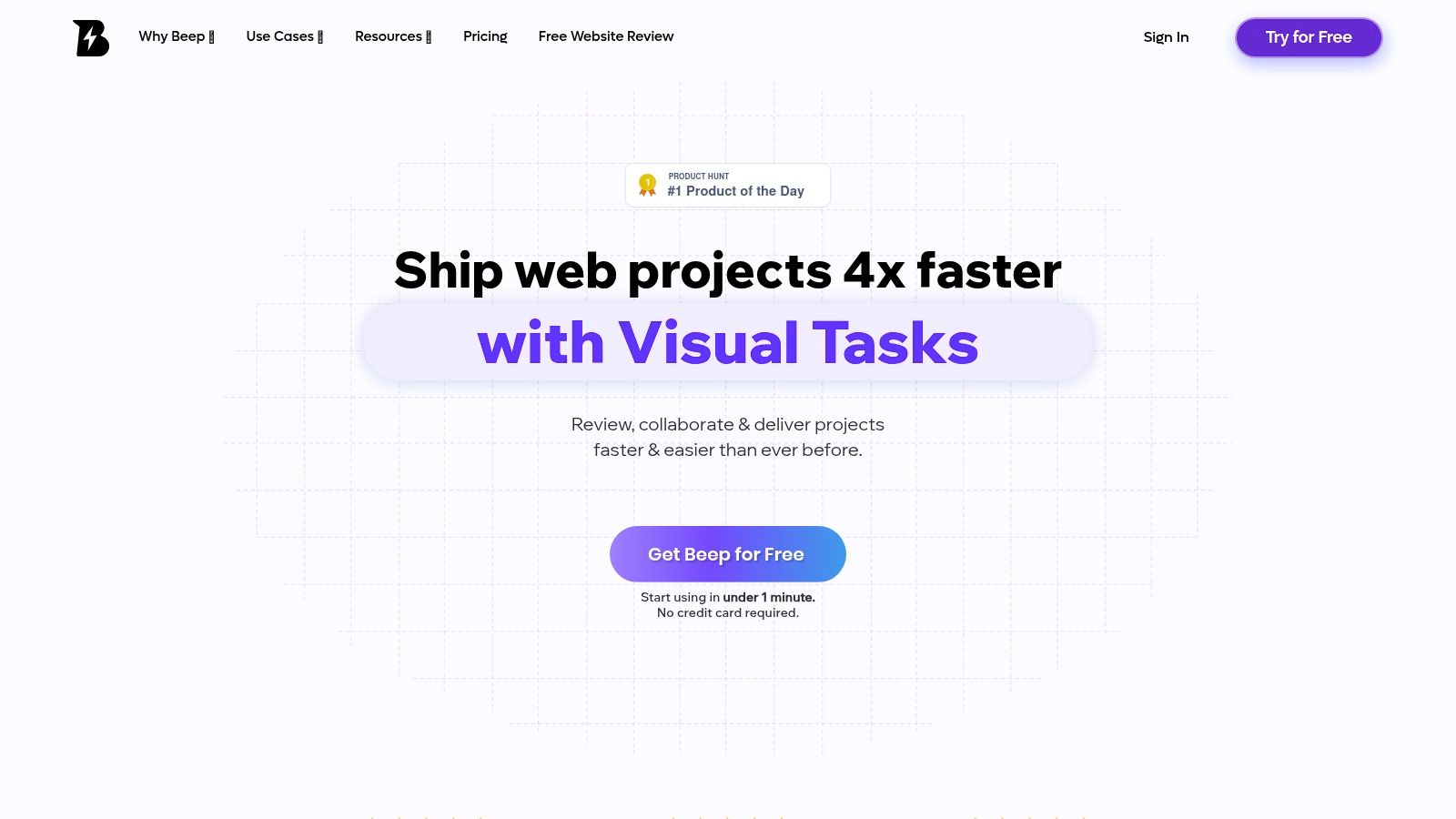
One of Beep's standout features is its built-in Kanban board. This allows teams to manage and track feedback as actionable tasks, ensuring that no comment gets lost or overlooked. Furthermore, seamless integrations with popular tools like Slack, Jira, Notion, Zapier, and more make it easy to incorporate Beep into your existing remote team collaboration workflow. Whether your team uses Slack for daily communication, Jira for project management, or Notion for documentation, Beep can fit seamlessly within your existing ecosystem. For product managers, UX/UI designers, developers, and marketing teams working remotely, this level of integration is crucial for maintaining productivity and smooth collaboration.
Beep also excels in its accessibility. With a quick onboarding process taking less than a minute and no credit card required to get started, teams of any size can quickly experience the benefits of streamlined web project feedback. This low barrier to entry makes it easy to experiment with and adopt Beep as a core component of your remote team collaboration toolkit.
Pros:
Visual Feedback: Direct annotations on live websites with automatic screenshots provide crystal-clear communication.
Task Management: Integrated Kanban board keeps feedback organized and actionable.
Seamless Integrations: Works with Slack, Jira, Notion, Zapier, and more.
Time Savings: Significantly reduces time spent on video calls, screenshots, and recordings.
Easy Onboarding: Get started in under a minute with no credit card required.
Cons:
Focus on Web Projects: While ideal for web projects, its direct application is limited for teams working extensively outside web environments.
Expanding Integrations: While core integrations are robust, more specialized integrations are still in development.
Website: https://www.justbeepit.com
Beep’s focus on visual feedback makes it a standout choice among remote team collaboration tools, particularly for web-based projects. Its intuitive interface and powerful integrations save teams valuable time and reduce misunderstandings, ultimately leading to faster and more effective project delivery. While its strength lies in web project feedback, teams focusing on other areas might find its application limited. However, for those working primarily on web development, design, and marketing, Beep deserves serious consideration as a tool to elevate remote team collaboration. Its frictionless onboarding process makes it easy to try and see the benefits firsthand.
2. Slack
Slack is a leading remote team collaboration tool, offering a channel-based messaging platform designed to streamline communication and enhance productivity. Instead of relying on email, teams can organize conversations into dedicated channels for specific projects, topics, or departments. This allows for focused discussions and prevents important information from getting lost in overflowing inboxes. Direct messaging is also available for quick one-on-one conversations between team members. Its robust integration capabilities further elevate Slack as a central hub for remote work, connecting with over 2,400 apps to manage workflows and consolidate notifications. This makes it a powerful solution for product managers, UX/UI designers, web developers, marketing teams, and any team working remotely.
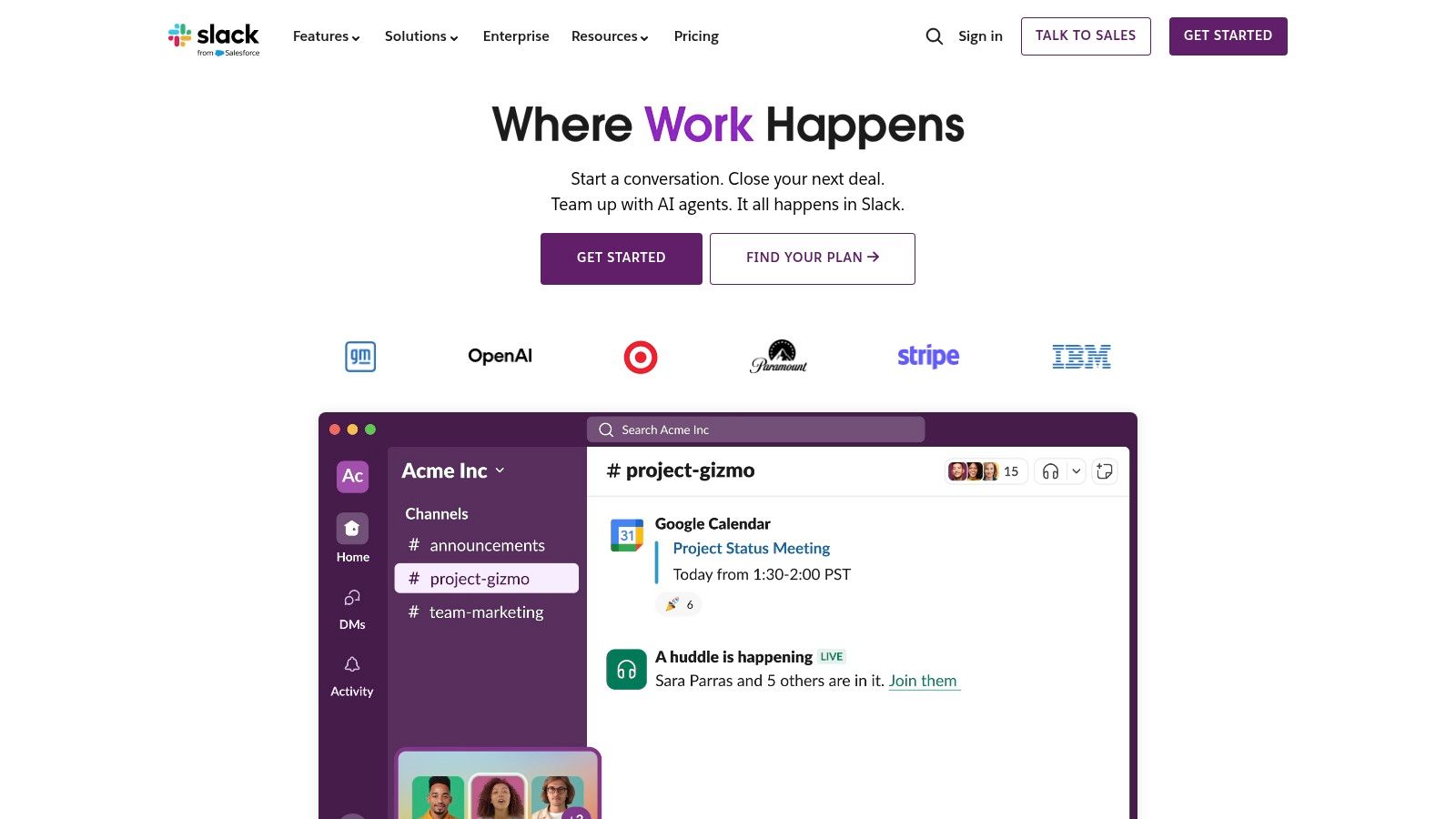
Slack's key features make it a valuable asset for remote team collaboration. File sharing is simplified with drag-and-drop functionality, making it easy to share documents, images, and other files directly within the platform. Built-in video and voice calls for up to 15 participants facilitate quick meetings and discussions without needing to switch to a separate platform. Its extensive app integration ecosystem, including popular tools like Google Drive, Salesforce, and Asana, allows teams to streamline workflows by centralizing information and notifications. The searchable message history and file archives provide a valuable repository for past communications and resources, although this feature is limited in the free version. Learn more about Slack and explore other potential options.
One of Slack's biggest strengths is its intuitive user interface, which makes it easy for teams to adopt and integrate into their workflows. The extensive integration ecosystem streamlines tasks and centralizes information, while the robust free tier option provides a valuable entry point for smaller teams. Excellent mobile apps allow for seamless on-the-go collaboration.
However, Slack also has some drawbacks. With extensive use, the platform can become overwhelming with the proliferation of channels and notifications. The limitation on message history in the free version can hinder access to past information. Pricing for larger teams can be substantial, and while video conferencing is available, its features are less robust than dedicated video conferencing solutions like Zoom or Google Meet.
Slack offers a free plan with limited features, a Pro plan at $7.25 per user per month, and a Business+ plan at $12.50 per user per month (billed annually). Technical requirements are minimal, requiring only an internet connection and a compatible device (desktop, mobile, or web browser). For teams seeking a robust and integrated communication platform, Slack deserves its place among the top remote team collaboration tools. However, teams should carefully consider their budget and communication needs to determine if Slack's features and pricing align with their requirements.
3. Microsoft Teams
Microsoft Teams is a powerful remote team collaboration tool that consolidates workplace chat, video meetings, file storage, and application integration into a single platform. It's particularly valuable for organizations already invested in the Microsoft 365 ecosystem, offering seamless access to familiar tools like Word, Excel, and PowerPoint directly within the Teams interface. This makes it a central hub for teamwork, streamlining workflows and enhancing productivity for remote and hybrid teams. Teams allows for real-time co-authoring of documents, simplifying collaborative projects and eliminating the need for constant file sharing and version control. Its robust features make it a strong contender in the landscape of remote team collaboration tools.
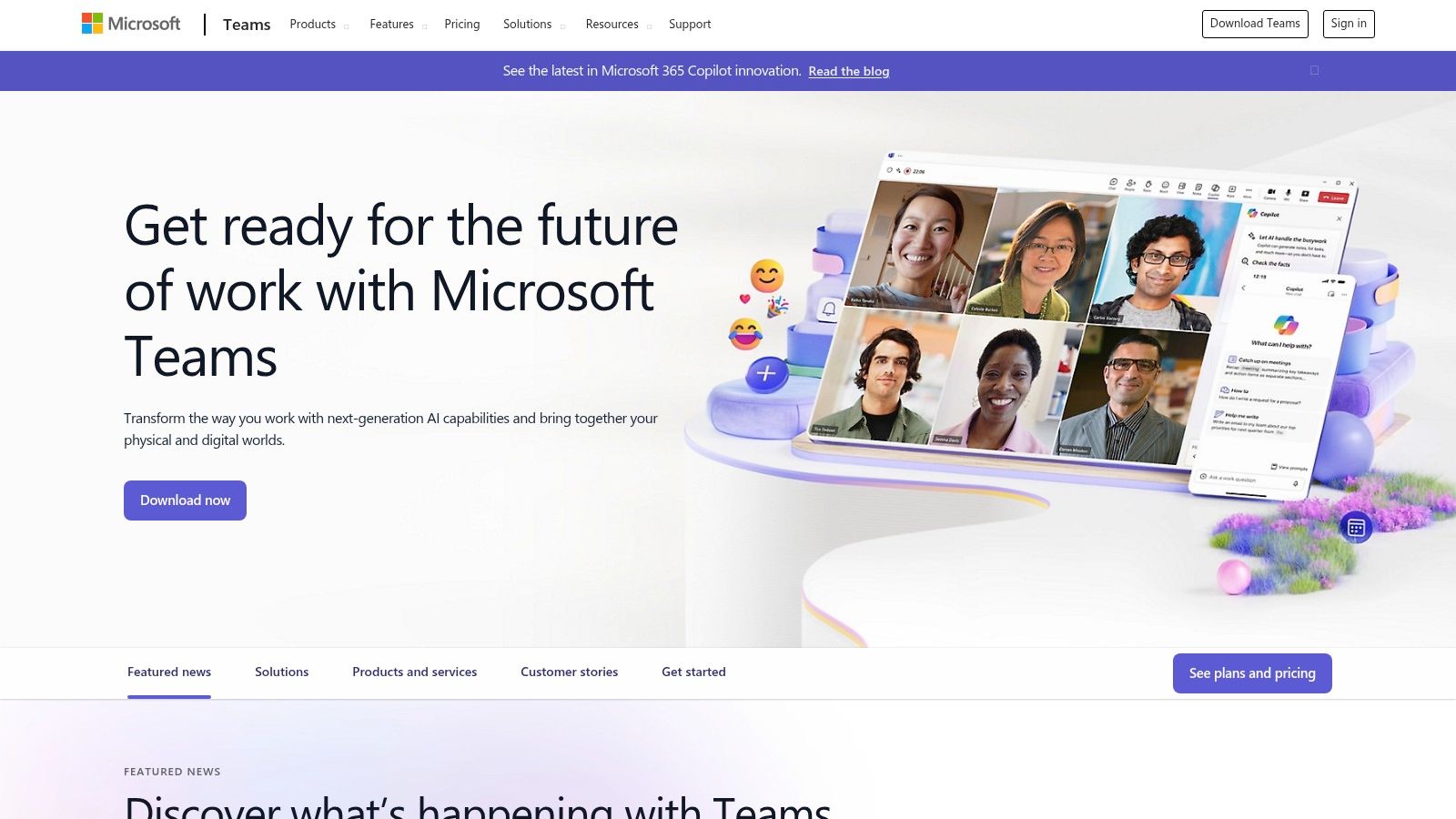
For product managers, Teams facilitates sprint planning and project management through shared workspaces and integrated task management apps. UX/UI designers can share design mockups and gather feedback directly within the platform. Web developers can collaborate on code and utilize integrated development tools. Marketing teams can leverage Teams for campaign planning, content creation, and performance tracking. The ability to create dedicated channels for specific projects or teams keeps communication organized and focused.
Teams offers video meetings with up to 300 participants (or 1,000 with the Premium tier), making it suitable for large team meetings, webinars, and training sessions. The "Tabs" functionality allows teams to embed frequently used apps and documents within specific channels, further centralizing workflows. For example, a marketing team could embed their project management software, content calendar, and analytics dashboards directly into their team channel.
Pricing and Technical Requirements: Microsoft Teams is included with many Microsoft 365 subscriptions at no additional cost. Stand-alone versions are also available with varying features and pricing tiers. Teams is compatible with Windows, macOS, iOS, Android, and web browsers, ensuring accessibility across different devices.
Comparison with Similar Tools: While Slack is known for its user-friendly interface and extensive third-party integrations, Teams stands out with its deep integration with the Microsoft 365 suite, making it a natural choice for organizations already utilizing those tools. Compared to platforms like Google Workspace, Teams offers more robust video conferencing features and tighter integration with Microsoft-specific applications.
Implementation and Setup Tips: To maximize the effectiveness of Teams, organizations should invest time in properly configuring team channels, setting clear communication guidelines, and training users on the platform's features. Leveraging the "Tabs" functionality to embed relevant apps and documents can significantly streamline workflows.
Pros:
Comprehensive all-in-one solution for Office 365 users
Strong security and compliance features
Excellent video conferencing capabilities
Included in many Microsoft 365 subscriptions at no additional cost
Cons:
Steeper learning curve than some competitors
Can be resource-intensive on computers
Interface can feel cluttered with many features
Works best within the Microsoft ecosystem
Microsoft Teams deserves its place on this list of remote team collaboration tools due to its comprehensive feature set, deep Microsoft 365 integration, and robust video conferencing capabilities. While the interface might require some initial learning, its power and versatility make it an invaluable tool for enhancing productivity and streamlining communication within remote teams.
4. Zoom
For remote teams seeking robust video conferencing, Zoom is a leading contender amongst remote team collaboration tools. It provides high-definition video and audio, screen sharing, and recording capabilities, making it ideal for virtual meetings, webinars, and training sessions. While primarily known for its video communication prowess, Zoom has evolved into a more comprehensive platform, incorporating features like persistent chat, phone service, and whiteboarding. This makes it a viable option for teams looking to consolidate their communication needs into a single platform.
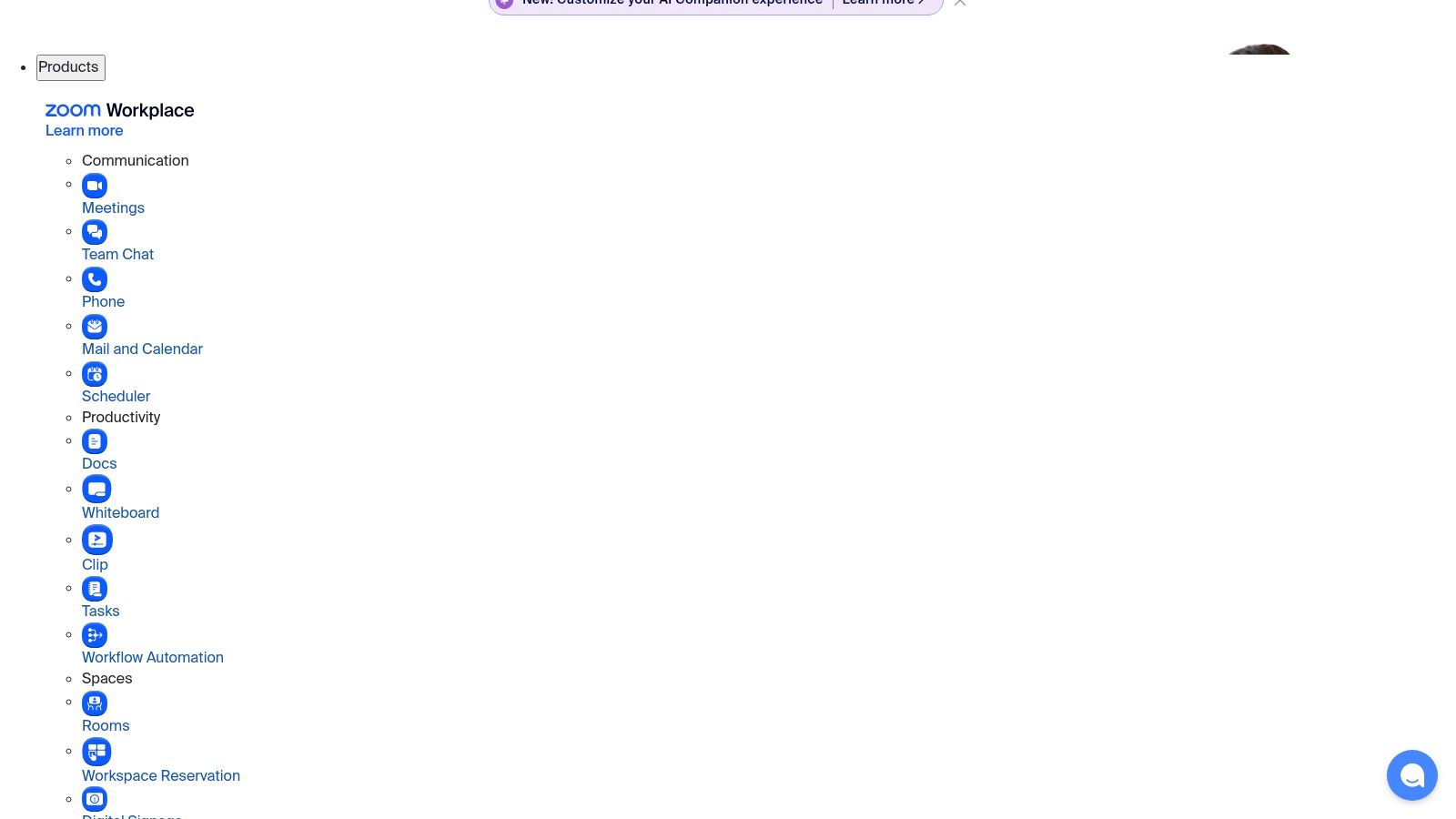
Product managers can leverage Zoom for product demos and stakeholder alignment meetings. UX/UI designers can conduct user testing and design reviews remotely. Web developers benefit from screen sharing and collaborative annotation for code reviews and troubleshooting. Marketing teams can use Zoom for webinars and client presentations. The breakout room feature is particularly useful for smaller team discussions and brainstorming sessions, promoting focused collaboration within larger meetings. The ability to record and transcribe meetings ensures that vital information is captured and accessible for later review, a valuable asset for any remote team.
Zoom offers a generous free tier that allows up to 100 participants in a meeting, albeit with a 40-minute limit on group meetings. Paid subscriptions unlock premium features like longer meeting durations, cloud storage for recordings, and advanced administrative controls. While pricing varies based on the chosen plan, even the free tier provides significant value for small teams. Learn more about Zoom and its various offerings.
Technical requirements are minimal, with desktop and mobile apps available for various operating systems. A stable internet connection is recommended for optimal performance, although Zoom is known for its relatively reliable performance even with limited bandwidth. Setting up Zoom is straightforward, requiring a simple download and installation process.
Pros:
Exceptional video and audio quality ensures clear communication.
Intuitive interface makes it easy for anyone to use, regardless of technical expertise.
Reliable performance even with limited bandwidth makes it accessible to users in various locations.
Generous free tier provides a valuable entry point for small teams or individuals.
Cons:
Limited project management capabilities mean it may need to be supplemented with other tools for comprehensive project tracking.
Past security concerns, though largely addressed, might still be a consideration for some users.
More focused on meetings than asynchronous collaboration, making it less suitable for teams who primarily communicate via chat or project management platforms.
Premium features, like cloud recording and longer meeting durations, require a paid subscription.
While alternatives like Google Meet and Microsoft Teams offer integrated solutions within their respective ecosystems, Zoom's focus on high-quality video and audio conferencing makes it a strong choice for teams prioritizing seamless virtual communication. Its robust features, ease of use, and generous free tier contribute to its deserved place in this list of remote team collaboration tools. If crystal-clear video and audio are paramount for your remote team's communication, Zoom should be at the top of your consideration list.
5. Asana
Asana is a powerful work management platform ideal for remote team collaboration. It helps teams organize, track, and manage their work, ensuring everyone stays on the same page regardless of location. Asana's flexible system allows for creating projects, assigning tasks, setting deadlines, and facilitating communication, making it a valuable tool for streamlining workflows and boosting productivity in remote settings. Its various visualization tools, such as Kanban boards, lists, calendars, and Gantt charts (Timeline view), provide a clear overview of project progress and individual responsibilities, fostering transparency and accountability within the team.
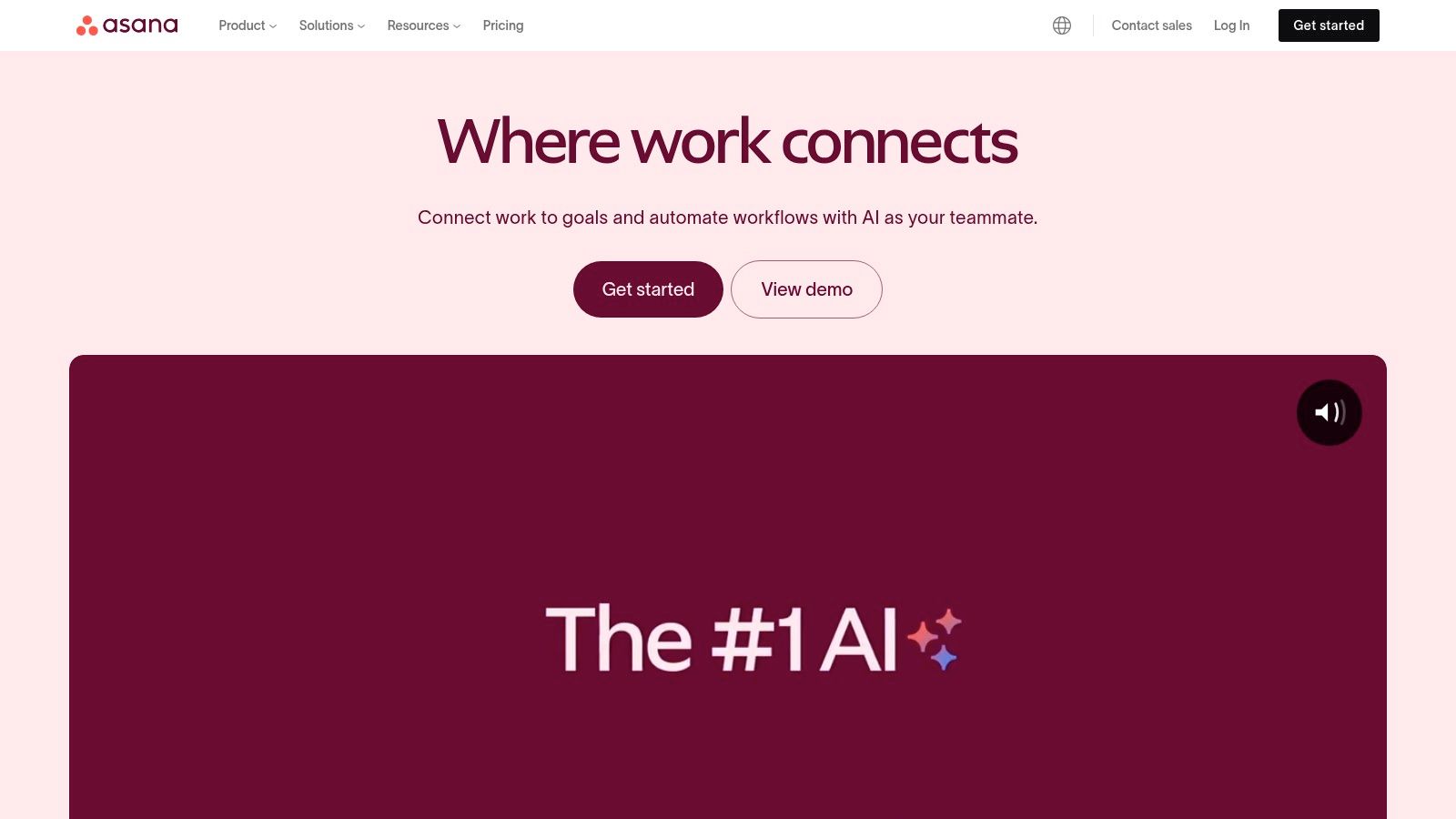
For product managers, Asana facilitates sprint planning and backlog grooming, ensuring smooth product development. UX/UI designers can utilize it to manage design tasks, track feedback, and collaborate on prototypes. Web developers can organize coding sprints, track bugs, and manage releases effectively. Marketing teams can plan and execute campaigns, manage content calendars, and track performance metrics. In essence, any remote team can leverage Asana to centralize their work and improve collaboration.
Asana deserves a place on this list due to its robust features and flexible nature. It's more than just a to-do list; it's a comprehensive work management solution. Features like task management with assignments, due dates, and dependencies, multiple project views (list, board, timeline, calendar), custom fields, and templates for different workflows allow teams to tailor Asana to their specific needs. Automation rules further streamline processes by reducing manual work, while progress tracking with milestones and reporting offers valuable insights into project health.
Pricing: Asana offers a robust free tier for teams up to 15 members. Paid plans unlock additional features such as reporting, advanced search, and custom branding, starting at around $10.99 per user per month.
Technical Requirements: Asana is a cloud-based platform accessible via web browser and mobile apps (iOS and Android). No specific hardware or software requirements exist beyond a stable internet connection.
Comparison with Similar Tools: While similar to tools like Trello and Monday.com, Asana distinguishes itself with its robust free tier and its focus on timeline management, making it particularly suitable for projects with complex dependencies. Trello shines with its simplicity and Kanban focus, while Monday.com offers highly visual dashboards and automation capabilities. The best choice depends on the specific needs and preferences of the team.
Implementation Tips:
Start small: Begin with a pilot project involving a small team to familiarize everyone with the platform.
Utilize templates: Asana offers a wide range of pre-built templates for various workflows, saving time and effort.
Customize workflows: Leverage custom fields and automation rules to tailor Asana to your team's specific processes.
Integrate with other tools: Connect Asana with other tools your team uses, such as Slack or Google Calendar, to centralize communication and streamline workflows.
Pros:
Highly customizable to fit different team workflows
Clean, user-friendly interface
Strong visualization of project timelines and dependencies
Robust free tier for teams up to 15 members
Cons:
Can become complex for very large projects
Limited communication tools compared to chat-focused platforms
Learning curve for advanced features
Some key features like reporting require paid plans
Website: https://asana.com
6. Trello
Trello is a highly visual project management and remote team collaboration tool that leverages the Kanban methodology. It uses boards, lists, and cards to represent projects, tasks, and their respective stages. This intuitive system makes it easy for teams to organize, prioritize, and track progress on projects of varying complexity. Each card can be packed with details, including checklists, due dates, attachments, discussions, and assigned team members, ensuring everyone has the information they need in one central location. This makes Trello an excellent choice for remote teams who need to stay synchronized and connected, regardless of location. It streamlines workflows and promotes transparency, vital components for successful remote team collaboration.
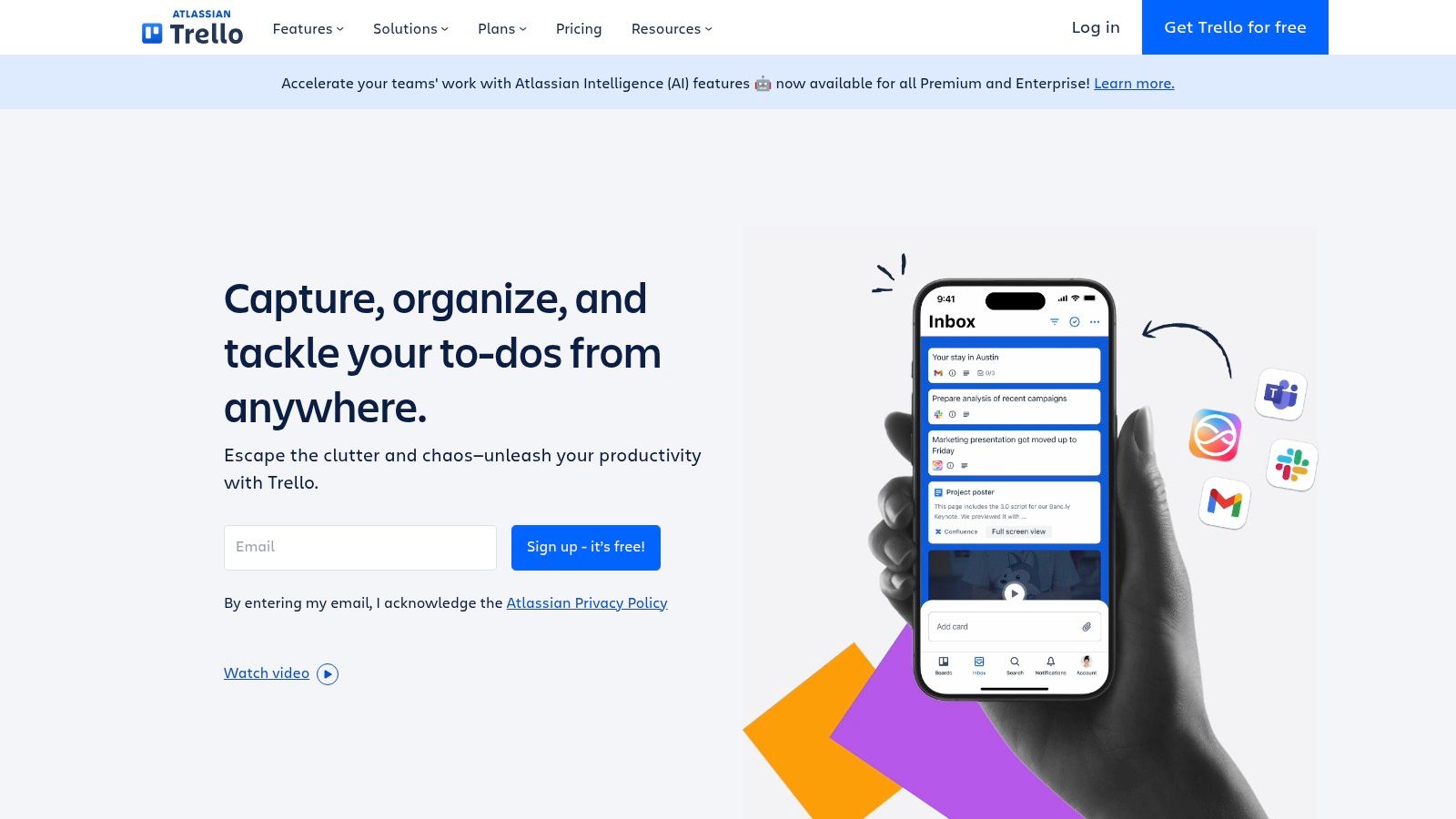
Trello’s flexibility makes it suitable for a variety of use cases, from managing marketing campaigns and software development sprints to coordinating design projects and tracking sales pipelines. For example, a marketing team can use Trello to manage the content creation process, moving cards through lists like "Idea," "Drafting," "Editing," "Review," and "Published." Similarly, a web development team can track bug fixes and feature implementations. UX/UI designers can use it to manage design iterations and gather feedback. The possibilities are vast, making it a powerful tool for diverse remote teams.
Key features include customizable Kanban boards with lists and cards, Power-Ups that extend functionality with features like calendars, voting, and time tracking, and card templates for recurring tasks. The Butler automation feature allows teams to create rules and scheduled commands to automate repetitive actions, further enhancing efficiency. Mobile apps with offline functionality allow team members to stay connected and productive even when they're on the go. You can learn more about Trello and its features for a deeper dive.
Trello offers a generous free tier, which is often sufficient for basic project management needs. Paid plans unlock advanced features like unlimited boards, advanced checklists, custom fields, and larger file attachments. While pricing details can vary, this tiered structure makes Trello accessible to both small teams and larger organizations. No specialized technical requirements are needed to use Trello; simply sign up and start creating boards.
Pros:
Extremely intuitive and easy to learn, requiring minimal onboarding time.
Highly visual approach to task management simplifies project tracking.
Flexible and adaptable to a wide range of use cases and team sizes.
Useful free tier for basic project management needs.
Cons:
Limited reporting capabilities in the basic version may be insufficient for data-driven teams.
Can become unwieldy for highly complex projects with numerous dependencies.
Advanced features require a paid subscription.
Not as robust for collaborative document editing compared to dedicated document management tools.
While tools like Asana and Monday.com offer more advanced features for dependency management and reporting, Trello shines in its simplicity and ease of use. This makes it a fantastic entry point for teams new to Kanban and a valuable remote team collaboration tool for those prioritizing a visual and straightforward approach to project management. The website, https://trello.com, provides further information and resources. A simple tip for implementation is to start with a basic board and gradually add complexity as your team becomes familiar with the platform. This ensures a smooth adoption process and maximizes the benefits of this powerful tool.
7. Google Workspace
Google Workspace (formerly G Suite) is a powerful suite of cloud-based applications designed to facilitate seamless remote team collaboration. It provides a centralized platform for teams to communicate, create, store, and manage projects, making it a valuable asset for remote work environments. From real-time document editing and video conferencing to shared calendars and cloud storage, Google Workspace offers a comprehensive solution for businesses seeking efficient remote team collaboration tools. Its integrated nature streamlines workflows and fosters better communication, boosting overall productivity.
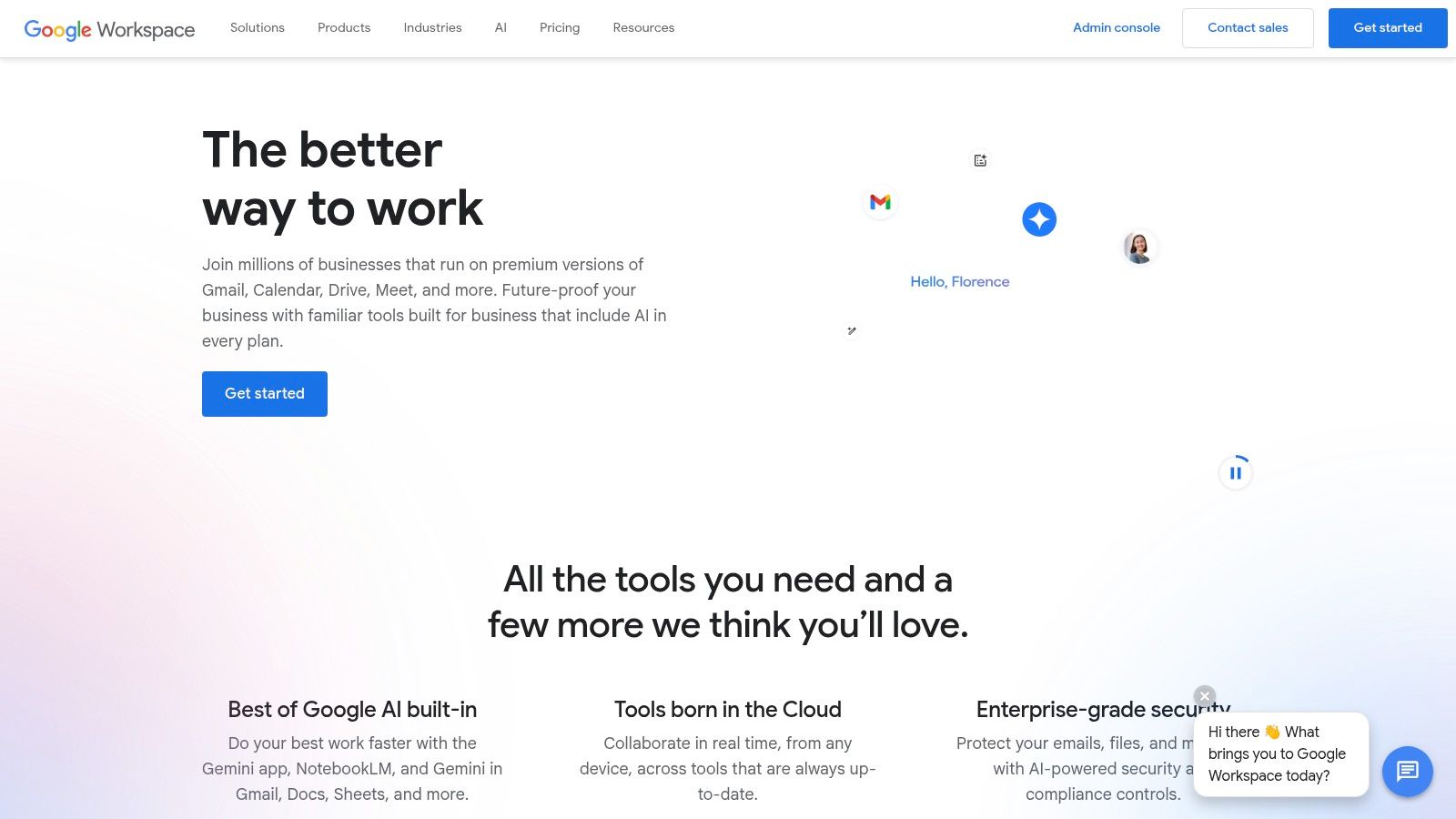
For product managers, Google Workspace enables collaborative product roadmapping and specification documentation using Docs, Sheets, and Slides. UX/UI designers can share design mockups and gather feedback in real-time using the same tools. Web developers can collaborate on code and documentation, leveraging the power of shared drives and real-time editing. Marketing teams can coordinate campaigns, manage content calendars, and track progress seamlessly. The versatility of Google Workspace makes it a valuable tool for diverse remote teams.
Key Features and Benefits:
Real-time Collaboration: Google Docs, Sheets, and Slides allow simultaneous editing, eliminating version control issues and fostering real-time feedback. This feature is particularly useful for remote teams working on collaborative projects.
Cloud Storage and File Sharing: Google Drive provides a centralized hub for file storage, sharing, and management. Remote teams can easily access and collaborate on files from any device, simplifying file management and ensuring everyone is working with the latest versions.
Video Conferencing and Screen Sharing: Google Meet facilitates seamless video conferencing and screen sharing, enabling effective communication and collaboration for remote team meetings, presentations, and training sessions.
Communication Tools: Gmail and Google Chat provide integrated communication channels, streamlining email communication and enabling quick messaging for enhanced team interaction.
Shared Calendars: Google Calendar simplifies scheduling and coordination across remote teams, ensuring everyone is aware of deadlines, meetings, and other important events.
Pricing and Technical Requirements:
Google Workspace offers a variety of plans tailored to different business needs. Pricing varies based on the number of users and the features included. A basic business plan starts at around $6 per user per month. Detailed pricing information can be found on the Google Workspace website. The platform is primarily web-based, requiring a stable internet connection for optimal performance. Mobile apps are also available for iOS and Android devices, further enhancing accessibility for remote teams.
Comparison with Similar Tools:
While Microsoft 365 offers a similar suite of tools, Google Workspace often stands out for its seamless real-time collaboration features and user-friendly interface. Its cloud-native architecture makes it highly accessible from any device with a web browser.
Implementation and Setup Tips:
Implementing Google Workspace is typically straightforward. Setting up a business account allows administrators to manage users, permissions, and security settings. Encouraging team members to utilize the various features, such as shared drives and real-time collaboration tools, can maximize the benefits of the platform.
Pros:
Seamless real-time collaboration with multiple editors
Familiar interface that most users already know
Accessible from any device with a web browser
Excellent reliability and uptime
Cons:
Limited offline functionality compared to desktop productivity suites
Requires a stable internet connection for optimal performance
Business plans are needed for advanced administrative features and enhanced security
Lacks built-in project management tools, requiring integration with third-party solutions.
Website: https://workspace.google.com
Google Workspace deserves its place on this list because it provides a comprehensive and integrated platform for remote team collaboration. Its user-friendly interface, real-time collaboration capabilities, and cloud-based accessibility make it an invaluable tool for remote teams across various industries. It empowers teams to communicate, create, and collaborate efficiently, ultimately enhancing productivity and streamlining workflows in the remote work environment.
8. Notion
Notion has quickly become a favorite among remote teams for its impressive versatility as a central workspace. It elegantly combines features of note-taking apps, document editors, wikis, databases, and project management tools, offering a powerful all-in-one solution that streamlines workflows and reduces the need for multiple disparate applications. This makes it a particularly compelling choice for remote team collaboration, enabling efficient communication and knowledge sharing regardless of location. Teams can create highly customizable workspaces tailored to their specific needs, fostering a more organized and productive environment. Whether you’re managing projects, documenting processes, or simply brainstorming ideas, Notion provides a flexible platform to centralize and connect your team’s work.
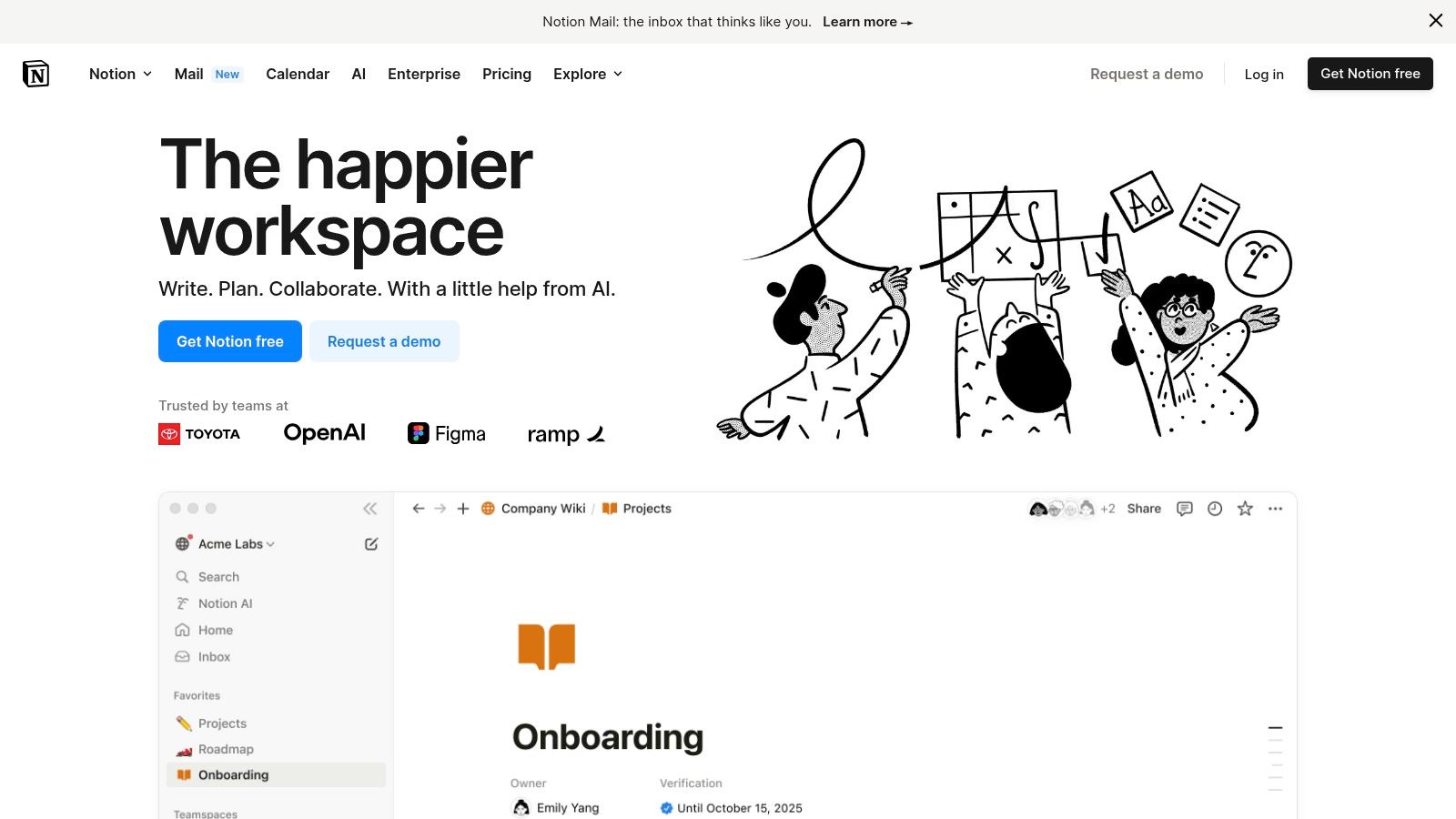
For product managers, Notion can be used to maintain product roadmaps, document user stories, and track progress on features. UX/UI designers can leverage Notion to create design systems, share mockups, and gather feedback. Web developers can use it for documentation, code snippets, and sprint planning. Marketing teams can centralize content calendars, campaign strategies, and performance data. The possibilities are virtually endless, making Notion a truly valuable remote team collaboration tool.
Features and Benefits:
Customizable Pages with Blocks: Notion's block-based system allows for highly flexible page customization. You can add text, images, tables, to-do lists, embedded files, and even code snippets, creating dynamic and interactive documents. This is particularly helpful for creating comprehensive documentation and knowledge bases.
Database Functionality: Notion's database feature is a powerful tool for project management and information organization. With multiple views (table, board, calendar, list, and gallery), teams can visualize data in a way that best suits their needs. This makes it easy to track progress, manage tasks, and prioritize work.
Wiki Capabilities: Notion's wiki functionality allows teams to build internal knowledge bases, document processes, and share important information easily. The linking capabilities allow for seamless navigation between related pages, fostering a truly interconnected workspace.
Templates: Notion offers a wide range of pre-built templates for various use cases, from project management and meeting notes to content calendars and design systems. This helps teams get started quickly and efficiently structure their work.
Granular Permissions: Notion allows for granular control over page access, enabling teams to share information securely and efficiently. You can control who can view, comment, and edit pages, ensuring that sensitive information remains protected.
Pros:
Extremely Versatile and Customizable: Notion adapts to a variety of workflows and team needs.
Replaces Multiple Tools: Consolidates multiple applications into a single platform.
Excellent for Documentation and Knowledge Management: Provides a centralized hub for all team information.
Strong Linking Between Related Information: Facilitates seamless navigation and knowledge discovery.
Cons:
Steep Learning Curve: Requires time and effort to master all the features.
Performance Can Slow with Large Workspaces: Large databases and complex pages can impact performance.
Mobile Experience Not as Robust as Desktop: Some features are limited on mobile devices.
Offline Functionality is Limited: Requires an internet connection for full functionality.
Pricing: Notion offers a free plan with limitations on the number of blocks and guests. Paid plans start at $8/user/month (billed annually) and offer increased functionality and storage.
Technical Requirements: Notion is web-based and accessible from any modern browser. It also offers desktop and mobile apps for Windows, macOS, iOS, and Android.
Comparison with Similar Tools: Notion is often compared to tools like Asana, Trello, and Confluence. While these tools excel in specific areas, Notion's strength lies in its all-in-one approach, offering a more comprehensive solution for remote team collaboration.
Implementation Tips:
Start with a template: Utilize Notion's pre-built templates to get started quickly.
Gradually introduce features: Don't try to implement everything at once. Focus on key features that will benefit your team the most.
Encourage team participation: The success of Notion implementation depends on team adoption. Encourage team members to explore and utilize the platform.
Website: https://www.notion.so
Notion earns its spot on this list of remote team collaboration tools due to its unparalleled flexibility, powerful features, and ability to centralize a wide range of workflows. While it may require some initial investment in learning the platform, the long-term benefits of improved collaboration and streamlined workflows make it a valuable tool for any remote team.
9. Miro
Miro is a powerful online whiteboard platform built specifically for remote team collaboration tools. It offers a virtually infinite canvas that allows distributed teams to brainstorm, plan projects, design workflows, and visualize ideas together in real-time. Miro excels at visual collaboration, making it a particularly strong choice for activities like design thinking workshops, agile sprint planning, user journey mapping, and collaborative design processes. It facilitates a dynamic and engaging workspace that transcends the limitations of physical whiteboards.
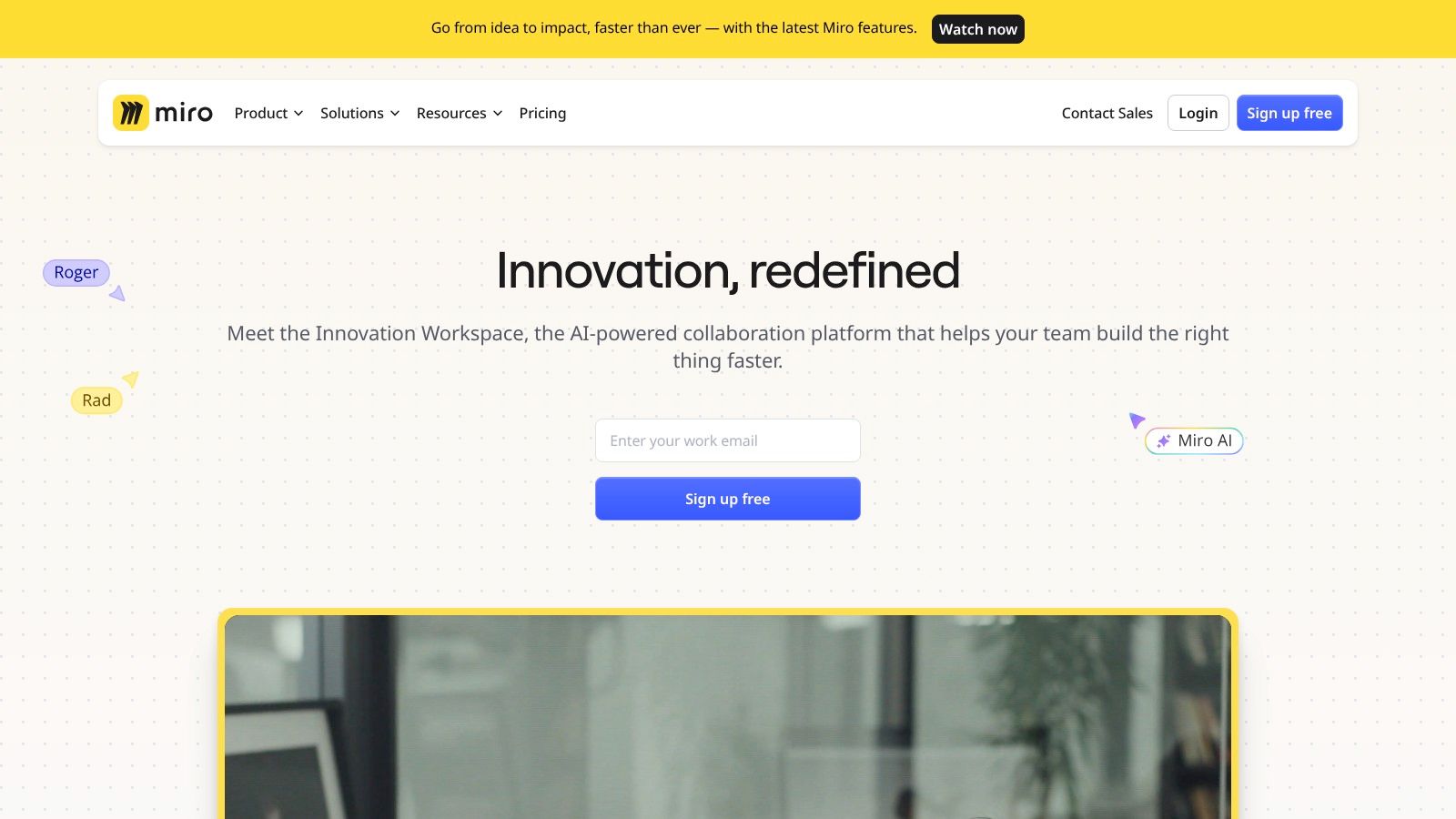
Miro’s feature set caters to a wide range of collaborative needs. Its infinite canvas allows for limitless brainstorming and project planning, eliminating the constraints of physical space. The platform provides a diverse toolset, including virtual sticky notes, shapes, connectors, mind map frameworks, and more. A rich library of pre-built templates for various methodologies (like Agile, Design Thinking, and Kanban) helps teams quickly get started with structured workflows. Integration with video conferencing tools further enhances real-time collaboration, allowing teams to visually discuss and iterate on projects while simultaneously seeing and hearing each other. Asynchronous collaboration is supported through version history and commenting features, allowing team members to provide feedback and contribute even when they can't be online at the same time.
Why Miro Deserves Its Place on this List: In the context of remote team collaboration tools, Miro stands out for its unmatched visual collaboration capabilities. While other tools may offer basic whiteboarding features, Miro’s infinite canvas, rich toolset, and template library make it a comprehensive solution for visual thinking and planning. Its intuitive interface enables seamless real-time collaboration, even for large distributed teams.
Pros:
Unmatched visual collaboration capabilities.
Excellent for brainstorming and design thinking.
Intuitive interface with seamless real-time collaboration.
Extensive template library for different use cases.
Cons:
The free plan is limited to 3 editable boards.
Can be overwhelming for simple text-based collaboration.
There is a slight learning curve for advanced features.
Premium features require a subscription.
Pricing: Miro offers a free plan with limited functionalities. Paid plans unlock additional features like unlimited boards, private boards, and advanced integrations. Specific pricing details are available on their website.
Technical Requirements: Miro is a web-based application accessible through most modern web browsers. Dedicated desktop and mobile apps are also available for enhanced functionality and offline access.
Comparison with Similar Tools: While tools like Mural and FigJam offer similar functionalities, Miro often stands out due to its extensive template library and its tight integration with other popular productivity tools.
Implementation/Setup Tips:
Start with a pre-built template relevant to your project or workflow.
Familiarize yourself with the basic tools and functionalities before diving into complex projects.
Leverage the integration with video conferencing tools for enhanced real-time collaboration.
Use the commenting and version history features for asynchronous feedback and tracking changes.
Website: https://miro.com
Miro's powerful features and intuitive interface make it a valuable asset for any remote team looking to enhance their visual collaboration and streamline their workflows. It is particularly well-suited for product managers, UX/UI designers, web developers, and marketing teams who frequently engage in brainstorming, planning, and design activities. Its ability to foster creativity and facilitate efficient communication makes it a top contender among remote team collaboration tools.
10. Basecamp: Streamlined Collaboration for Focused Remote Teams
Basecamp is a popular choice among remote teams seeking a straightforward, all-in-one platform for project management and communication. It prioritizes simplicity and organization, offering a centralized hub for file sharing, discussions, task management, and scheduling. Unlike tools that bombard users with constant notifications, Basecamp champions asynchronous communication, allowing distributed teams to work effectively across time zones without the pressure of real-time responses. This makes it ideal for teams who value deep work and minimizing distractions.
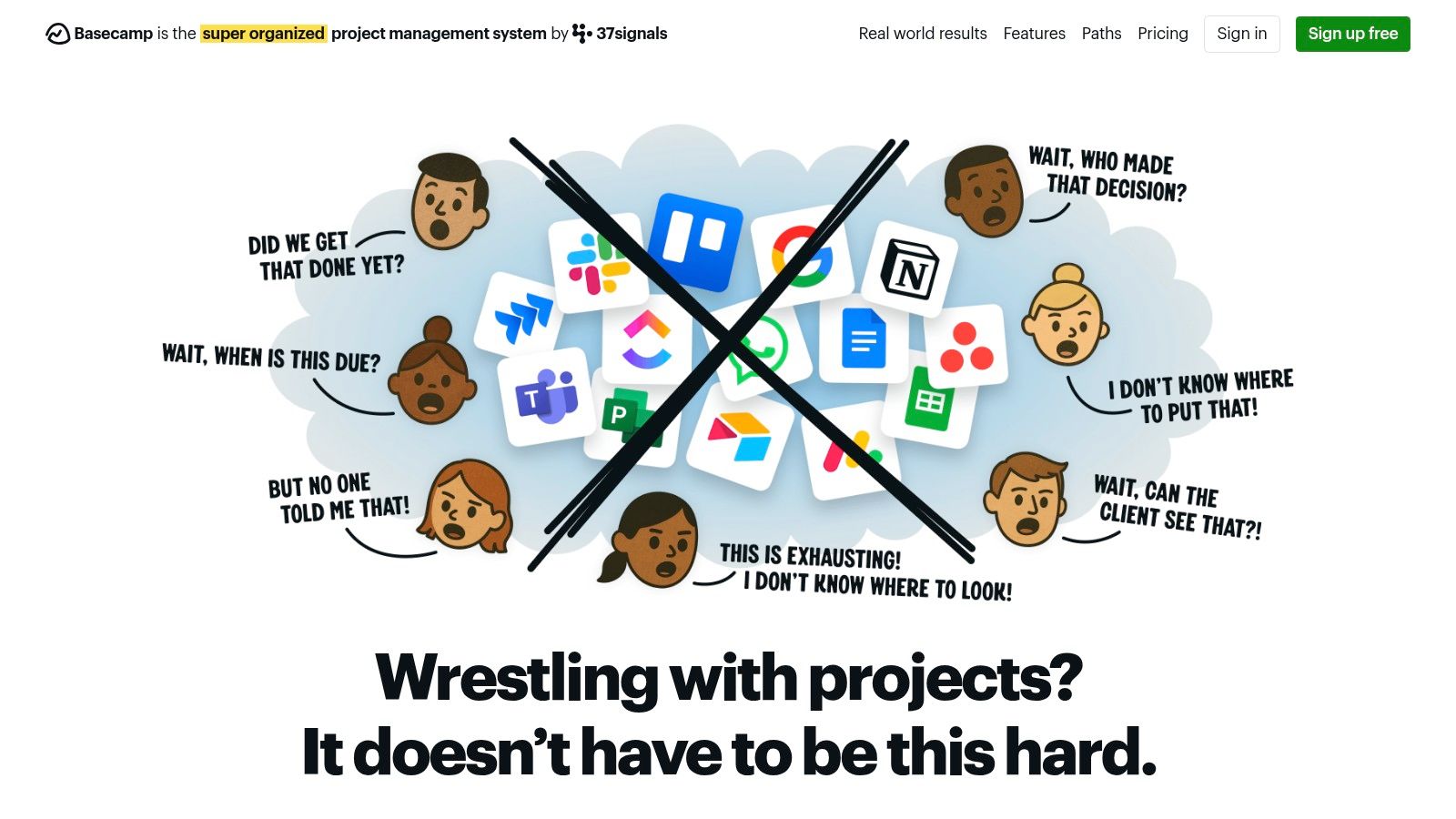
Basecamp's key features cater to the essential needs of remote team collaboration. To-do lists facilitate task assignment and progress tracking, while message boards provide dedicated spaces for team discussions and brainstorming. The built-in schedule helps teams keep track of important dates and milestones, and the document and file storage system includes version history for easy access to previous iterations. Automatic check-in questions streamline status updates, reducing the need for frequent meetings.
For remote teams distributed across different time zones, Basecamp's emphasis on asynchronous communication is a major advantage. Team members can contribute and respond when it suits their schedule, promoting a healthier work-life balance. Features like Hill Charts provide a visual overview of project progress, making it easy for everyone to stay informed.
While Basecamp excels in simplicity and focused communication, it does have some limitations. Customization options are less extensive than some other project management tools, and it lacks built-in time tracking. Integrations with third-party apps are also fewer compared to competitors, and advanced features like Gantt charts are absent. This makes it less suitable for complex projects requiring granular control and extensive reporting.
Pros:
All-inclusive pricing with no per-user fees makes budgeting predictable.
Clean, straightforward interface ensures a minimal learning curve for new users.
Excellent for asynchronous communication across time zones, promoting flexibility and work-life balance.
Hill Charts offer valuable visualizations of project progress.
Cons:
Limited customization compared to tools like Asana or Trello.
No built-in time tracking functionality.
Fewer integrations than competitors.
Lacks Gantt charts and advanced project management features.
Pricing: Basecamp offers a single flat fee for unlimited users and projects, making it a cost-effective solution for growing teams.
Technical Requirements: Basecamp is accessible through a web browser and dedicated mobile apps for iOS and Android devices, ensuring compatibility across various platforms.
Implementation Tips: When setting up Basecamp for your remote team, start by clearly defining projects and assigning team members to specific roles. Utilize the message boards for focused discussions and leverage the to-do lists for task management. Encourage team members to utilize the check-in questions for consistent progress updates.
Comparison: While tools like Asana and Trello offer more flexibility and customization, Basecamp's strength lies in its simplicity and focus on reducing noise. If your remote team prioritizes streamlined communication and a clutter-free workspace, Basecamp is a strong contender amongst remote team collaboration tools.
Website: https://basecamp.com
Top 10 Remote Collaboration Tools Comparison
Product | Core Features / Highlights | User Experience / Quality | Unique Selling Points | Target Audience | Price & Value |
|---|---|---|---|---|---|
🏆 Beep | Visual feedback on live sites with automatic screenshots ✨Built-in Kanban boardSeamless Slack, Jira, Notion integration | Saves hundreds of hours weekly ★★★★☆Quick onboarding (<1 min) | Direct website annotations ✨Product Hunt #1 Product of the Day | 👥 PMs, UX/UI designers, developers, marketing teams, remote collaborators | 💰 Free start, accessible for all team sizes |
Slack | Channel-based messagingFile sharing & calls2400+ app integrations | Intuitive UI ★★★★☆Robust mobile apps | Extensive integration ecosystem ✨ | 👥 Teams needing real-time chat & notifications | 💰 Free tier, can be costly for large teams |
Microsoft Teams | Video meetings (up to 300)MS 365 integrationReal-time co-authoring | Comprehensive but steep learning curve ★★★★☆ | Deep MS ecosystem integration ✨ | 👥 Office 365 users, enterprises | 💰 Included with MS 365; scalable pricing |
Zoom | HD video conferencing (100 participants)Breakout roomsRecordings and transcription | Exceptional video/audio quality ★★★★★ | Best-in-class video capabilities 🏆 | 👥 Remote teams needing video-first collaboration | 💰 Free tier (40 min limit); paid for premium features |
Asana | Task managementMultiple project views (Kanban, calendar)Automation rules | Highly customizable ★★★★☆ | Flexible workflows and strong visualization | 👥 Project managers, teams tracking tasks | 💰 Free tier up to 15 members; paid for full features |
Trello | Visual Kanban boardsPower-Ups & automationMobile with offline mode | Extremely intuitive ★★★★☆ | Simple Kanban task tracking ✨ | 👥 Small to medium teams & agile workflows | 💰 Free tier; paid for advanced features |
Google Workspace | Real-time doc collaborationCloud storage & sharingGmail & Meet included | Familiar & reliable ★★★★☆ | Seamless multi-app ecosystem | 👥 Teams needing cloud productivity | 💰 Subscription-based, scalable tiers |
Notion | All-in-one workspace (docs, projects, wikis)Customizable databasesTemplates galore | Versatile but steep learning curve ★★★★☆ | Single tool replacing many ✨ | 👥 Teams needing documentation + project management | 💰 Free for personal; paid for advanced collaboration |
Miro | Infinite whiteboard canvasReal-time collaborationTemplate library | Excellent visual collaboration ★★★★☆ | Best for brainstorming & design workflows 🏆 | 👥 Creative teams, designers, agile coaches | 💰 Free limited boards; subscription needed for full use |
Basecamp | To-do listsMessage boardsSchedule & docs | Clean, simple UX ★★★☆☆ | All-in-one with flat pricing 🏆 | 👥 Teams focused on async comms & simple project mgmt | 💰 Flat fee, no per-user pricing |
Empowering Your Remote Team for Success
Selecting the right remote team collaboration tools is crucial for maximizing productivity and nurturing a strong team dynamic in today's digital work landscape. From facilitating seamless communication (like with Slack and Microsoft Teams) to streamlining project management (using tools like Asana, Trello, or Basecamp), the platforms discussed in this article—Beep, Slack, Microsoft Teams, Zoom, Asana, Trello, Google Workspace, Notion, Miro, and Basecamp—cater to a diverse range of needs. We've also looked at visual collaboration with Miro and comprehensive documentation and knowledge management with Notion. By understanding the strengths of each tool, you can effectively address the unique challenges and opportunities presented by remote work.
One of the key takeaways is the importance of aligning your tool choices with your team's specific workflows. For example, if real-time communication is paramount, prioritizing tools like Beep or Slack might be ideal. If your team relies heavily on visual collaboration, exploring Miro could be beneficial. When implementing these tools, consider factors like ease of use, integration capabilities with existing systems, security features, and overall cost. Effective onboarding and training for your team will also be crucial for successful adoption. For further insights into building a strong online presence for your remote team, especially through content marketing and communication, consider setting up a company blog.
Ultimately, the right remote team collaboration tools empower your team to communicate effectively, manage projects efficiently, and foster a sense of connection regardless of location. By carefully selecting and implementing these tools, you can create a thriving virtual workspace that drives productivity and innovation. Ready to experience seamless team communication and collaboration? Explore Beep, a powerful platform designed to enhance your remote team's workflow and communication in one central hub. It's a valuable addition to your toolkit of remote team collaboration tools.

.png)
Comments